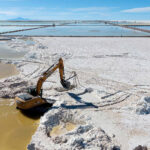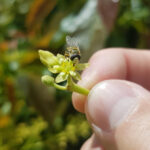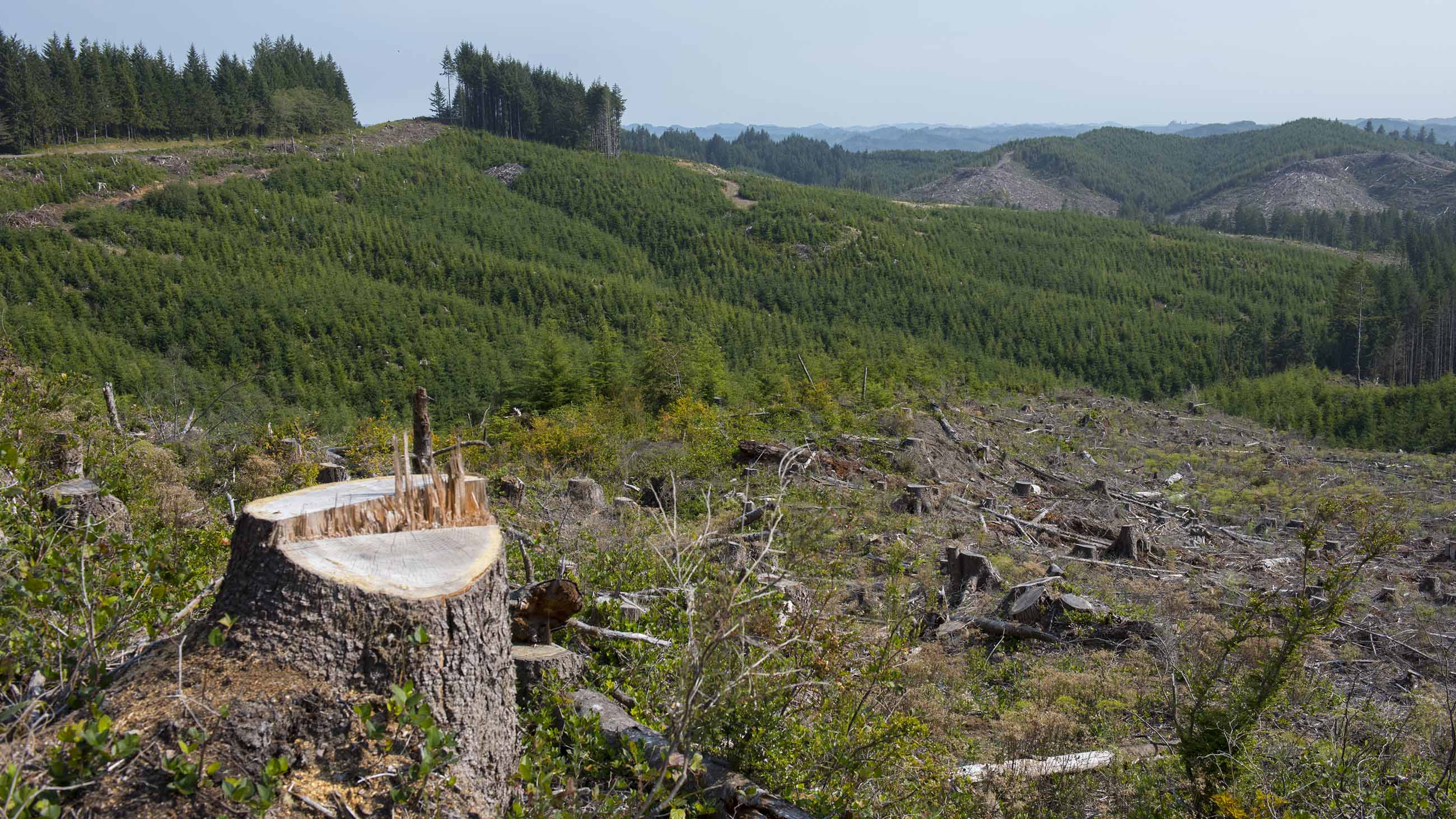A Clearer View of Forest Clearcutting
A forest stands tall one week, conifers reaching toward the sun with fringed fingers while ferns and shrubs carpet the cool forest floor below. The next week, the forest is gone — replaced with stumps and a tangle of vegetation. Sunlight streams to the ground unfettered. Small tree seedlings poke their bright green leader branches out of the brush.
This is a common sight in the foothills of the Coast Range in Oregon. Old-growth forest is long gone, and any of the ancient firs that once thrived on these hills were harvested around the turn of the 20th century, while the trees being felled today were almost certainly planted by human hands. Swaths of forest, on hillsides and in valleys, are cut down all at once in a flurry of chainsaws — raw materials for telephone poles, lumber and plywood.

These dramatic clearcuts have been controversial in the Pacific Northwest for decades. They’ve sparked heated debates and motivated activists to chain themselves to trees. Over the years, I’d mostly remained neutral on the topic, ignoring the uproar. That all changed when my father recently told me he’d be clearcutting the 20 acres of Douglas fir timber behind the house where I grew up. I’d grown accustomed to seeing clearcuts on nearby hillsides, but a clearcut on our hillside? I realized I couldn’t be neutral any more, and that I was going to have to have a conversation with my dad about the future of our trees.
But first, it was time to find out what the science said.
I spoke with Jason Barker, an ecologist and post-doctoral fellow at the University of British Columbia, who has published frequently on the issue of clearcuts. “I hesitate before making widespread, sweeping generalizations,” he warned me, but then he added: “There are a few relative certainties in the debate about clearcutting.” Indiscriminately cutting down all the trees on a hillside, Barker said by way of example, was universally understood to be a bad idea. So, too, is clearcutting in an area with poor soil quality.
Clearcutting on hills leaves soil in a precarious position. Even with replanting, erosion is a serious concern. Heavy rains strip away the topsoil (and any lingering chemicals like fertilizers or chainsaw oil), carrying it down the hillside and into streams that may be home to salmon and other important fish species.
The soil quality before the rains come is important, too. “If you have an area that’s classified as poor soil, you’re taking a much bigger risk if you decide to clearcut,” Barker said.
Poor soil means fewer nutrients and less biodiversity among the denizens of the dirt, like fungi and insects. And that can mean a slow regeneration. Oregon law requires land owners to replant two trees for every one they cut down, but if they don’t have good soil to grow in, the forest takes longer to bounce back.
The stretch of forest I trekked through as a child is perched on a hillside with a spring and creek at the bottom. In some areas, the hill’s slope is gentle and easy, but would the steeper areas be problematic? As far as I know, our soil quality is decent, but would it all wash away into the stream during the first big rainstorm if we stripped away the anchoring trees?
I also wondered where wildlife would live after all the trees were gone. Barker noted that the complexity of the surrounding landscape is really important when it comes to wildlife like elk, bears, birds and small rodents. “Some wildlife and critters are going to like hanging out in the clearcut or accessing the clearcut,” he said, but only if there’s young vegetation they can eat. Other species, such as the spotted owl, prefer older vegetation, like mature trees, and will make their way to another patch of forest nearby. As long as our clearcut isn’t surrounded by other clearcuts, wildlife will have somewhere to go.
“There’s definitely risk in harvesting” the wood, Baker said. “And no amount of careful planning can make that risk goes to zero.” A particularly dry year after replanting could make it hard for the young planted trees to grow, for example, or a particularly rainy year could wash away more soil than expected. Nature will always be the biggest variable. But Barker said good management was an important factor, too. “If you have a good owner, I think that counts for a lot.”
That was reassuring to hear. A lot of the time, it feels like so many variables are out of a landowner’s control. Weather, fire and pests are constant threats, and the best anyone can do is make careful decisions. It’s always been clear to me that my father cares deeply about our forest and the outdoors, and I know he’s always strived to make the best management decisions.
Stephen Fitzgerald, a forester for Oregon State University’s Extension Service and the manager of OSU’s research forest, views forestry as a social science. “It comes down to values,” he said. “If you had a plot of land and brought in ten different people, there’d be ten different ideas on how to manage a piece of ground.” In other words, I would never find a purely objective answer about clearcutting on our property. “Your dad is operating with a set of values that are objectives that he has,” Fitzgerald told me. “It sounds like you have some other values you want to impose.”
He wasn’t totally wrong. I wondered what it would take to let the forest become an old-growth stand and simply be wildlife habitat. It seemed like a decent alternative to clearcutting.
Fitzgerald pointed out that different species require different management decisions, but he offered the example pileated woodpeckers. They like bigger trees to nest in, Fitzgerald noted, especially trees larger than 20 inches in diameter. “It doesn’t matter to a pileated woodpecker whether that 20 inches is 100 years old or 50 years old,” he said. A landowner can also speed up the process and get bigger trees faster by carefully thinning a forest. “You can make these stands have premature grey hair,” Fitzgerald quipped.
But some forest characteristics can only develop with the passage of time, so without a specific species in mind, letting the forest sit might not really help wildlife significantly. Managing for wildlife requires more than just letting the trees grow unattended, and clearcutting requires careful planning and replanting. Either way, an active landowner is imperative.
Our stand of trees is mostly surrounded by other mature stands of timber and Christmas trees, so wildlife has somewhere to go. And by clearcutting our stand, we could potentially help to diversify the local ecosystem, providing habitat for species that like young forests.
Given these new insights, I sat down with my father to talk about the future of the forest I grew up loving. He admitted that it was a tough decision for him to make. “I kind of feel bad that I’m going to change the environment back there,” he told me. But that change is necessary in his eyes. “It is a tree farm, so you need to manage it, and this is part of the management plan. I don’t view a clearcut as really a permanent thing. You replant.” The seemingly constant Oregon rain also makes the decision a little easier for him, because trees grow pretty quickly here. “It’ll be harvestable in your lifetime,” he said. “That’s the cycle of a tree farm.”
And it was then that I realized that this is really what our property is: a tree farm — all 36 acres of it. Cutting down 20 acres of trees and walking away is unsustainable. Cutting down 20 acres of trees and then replanting and carefully managing the forest is sustainable, and the next logical step for our tree farm. And if one day, when I’m the manager of our tree farm, I decide to leave the next generation of trees to the the pileated woodpecker or the spotted owl, I can carefully manage the forest based on my own values.
Sometimes you measure time in tree rings when you grow up on a piece of land like ours. The year I graduated from high school is eight pairs of light and dark rings from the outer bark on some of the mature trees. The year my family moved to the farm is another fifteen paired rings closer to the center. Soon, I’ll have plenty of stumps to count rings on, and a better view of Mt. Hood.
That view will be bittersweet — a stark reminder of the loss of the trees that towered over me since childhood. But I’ll take comfort in knowing that before long, another generation of Douglas firs will grow up on that hillside, and they’ll hide that view of the mountain again, as they ascend to the sun.
Kelsey R. Kennedy is a graduate of Oregon State University, where she received a B.S. in economics with a minor in actuarial science. She is currently pursuing a masters degree in the Science, Health and Environmental Reporting Program (SHERP) at New York University. This article is provided by Scienceline, a project of SHERP.











Comments are automatically closed one year after article publication. Archived comments are below.
Barker’s insight is particularly valuable, since clearcutting is a tool that must be applied only where appropriate. It works must better on the Coast Range than on interior landscapess, particularly the serpentine and granite soils of southern Oregon and the dry forests of eastern Oregon. Weyerhauser has a great clearcut rotational program that works well in Washington state. When clearcuts are done in the wrong places it is not just the visual impact, but the complex ecological impact that pays the price.